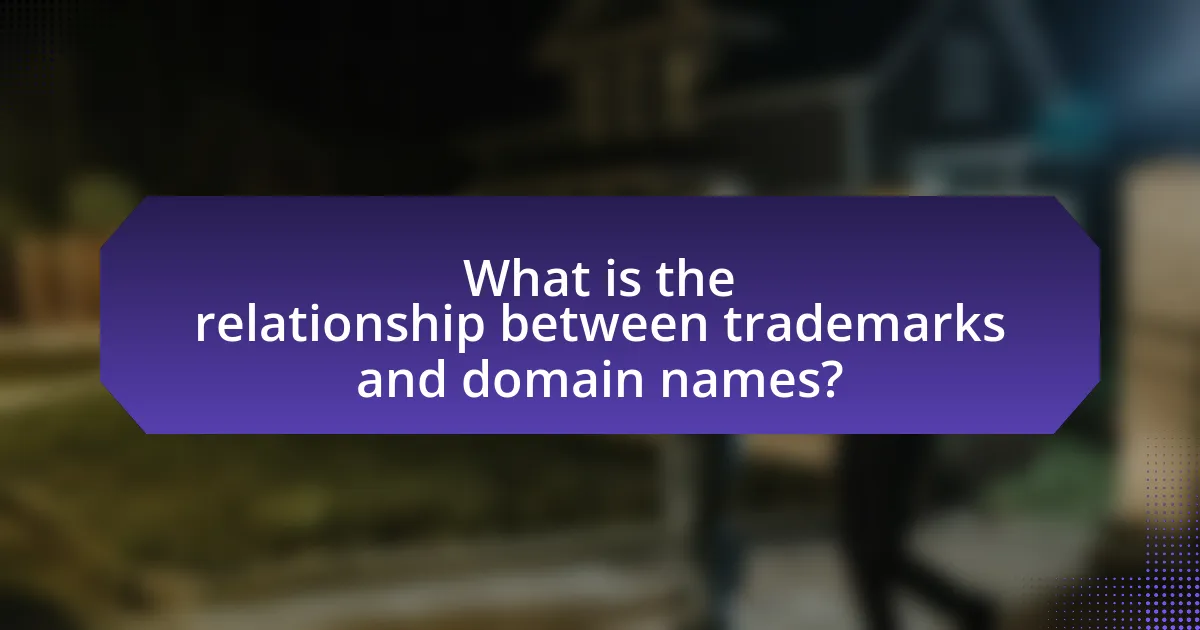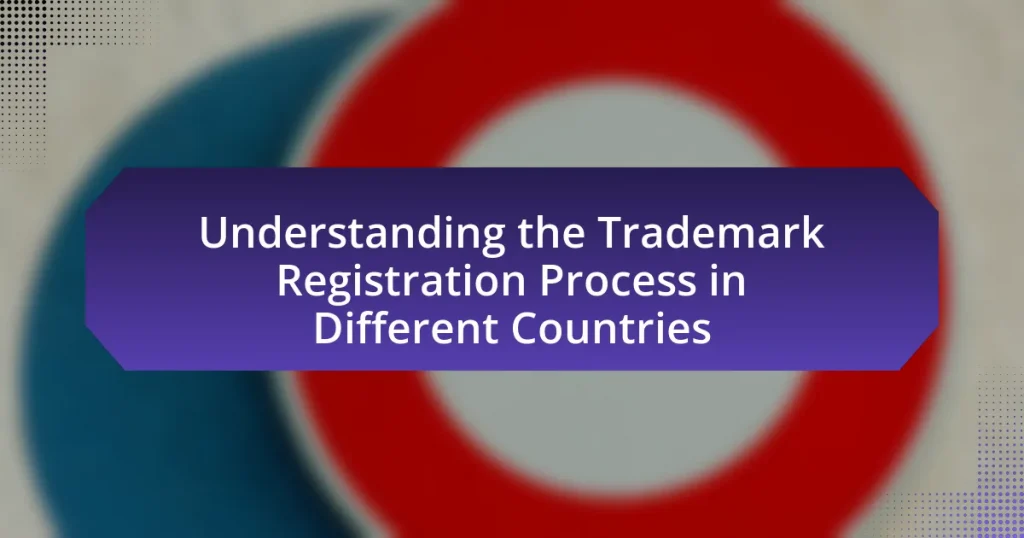Trademarks and domain names are integral components of brand identity in the marketplace, with trademarks protecting brand identity and domain names serving as online addresses. The article explores the legal relationship between trademarks and domain names, highlighting how trademarks influence domain name registration and the potential for legal disputes arising from trademark infringement and cybersquatting. It discusses the legal frameworks governing these issues, such as the Anticybersquatting Consumer Protection Act and the Lanham Act, and outlines best practices for businesses to navigate this relationship effectively. Additionally, the article addresses the challenges and emerging trends in the digital landscape, emphasizing the importance of proactive trademark management to safeguard brand integrity.

What is the relationship between trademarks and domain names?
Trademarks and domain names are closely related as both serve to identify and distinguish goods and services in the marketplace. Trademarks protect brand identity, while domain names provide an online address for that brand. The relationship is significant because a domain name can infringe on a trademark if it is identical or confusingly similar to a registered trademark, leading to potential legal disputes. For instance, the Anticybersquatting Consumer Protection Act in the United States allows trademark owners to take action against individuals who register domain names that are identical or confusingly similar to their trademarks with the intent to profit from the brand’s reputation. This legal framework underscores the importance of aligning domain name registration with trademark rights to avoid conflicts and protect brand integrity.
How do trademarks and domain names interact in the digital landscape?
Trademarks and domain names interact in the digital landscape primarily through the protection of brand identity and the prevention of consumer confusion. Trademarks serve as legal identifiers of goods or services, while domain names provide an online address for those goods or services. When a domain name incorporates a trademark, it can lead to legal disputes if it causes confusion among consumers regarding the source of the goods or services. For instance, the Anticybersquatting Consumer Protection Act (ACPA) in the United States allows trademark owners to take action against individuals who register domain names that are identical or confusingly similar to their trademarks with the intent to profit from the trademark’s goodwill. This legal framework underscores the importance of aligning domain name registration with trademark rights to avoid infringement and protect brand integrity.
What are the legal definitions of trademarks and domain names?
Trademarks are legally defined as distinctive signs, symbols, or expressions that identify and distinguish the source of goods or services of one entity from those of others, as established under the Lanham Act in the United States. Domain names are defined as human-readable addresses used to access websites on the internet, which are registered through domain name registrars and governed by the Internet Corporation for Assigned Names and Numbers (ICANN) policies. The legal framework for trademarks protects brand identity and prevents consumer confusion, while domain names serve as unique identifiers for online presence, often reflecting trademarked names to enhance brand recognition.
How do trademarks influence domain name registration?
Trademarks significantly influence domain name registration by establishing legal rights over specific names and symbols associated with goods or services. When a trademark is registered, it grants the owner exclusive rights to use that mark in commerce, which extends to domain names that are identical or confusingly similar to the trademark. This legal protection helps prevent unauthorized use of the trademark in domain names, thereby reducing the risk of consumer confusion and brand dilution. For example, the Anticybersquatting Consumer Protection Act (ACPA) in the United States allows trademark owners to take legal action against individuals who register domain names that infringe on their trademarks, reinforcing the importance of trademarks in domain name registration.
Why are trademarks important for domain names?
Trademarks are important for domain names because they provide legal protection and help establish brand identity online. A trademark ensures that a business can prevent others from using similar domain names that could cause confusion among consumers, thereby safeguarding its reputation and market position. For instance, the Lanham Act in the United States allows trademark owners to take legal action against domain names that infringe on their trademarks, reinforcing the significance of trademarks in maintaining distinctiveness and preventing brand dilution in the digital space.
What role do trademarks play in protecting brand identity online?
Trademarks play a crucial role in protecting brand identity online by legally distinguishing a company’s goods or services from those of others. They provide exclusive rights to use specific symbols, names, or phrases, which helps prevent consumer confusion and unauthorized use by competitors. For instance, a registered trademark can be enforced against domain names that are identical or confusingly similar, thereby safeguarding the brand’s reputation and integrity in the digital marketplace. This legal protection is vital, as it allows businesses to build trust with consumers and maintain their unique identity amidst the vast online landscape.
How can trademarks prevent domain name disputes?
Trademarks can prevent domain name disputes by providing legal protection that establishes ownership and exclusive rights to a brand’s identity. When a trademark is registered, it grants the owner the ability to take legal action against unauthorized use of the mark, including in domain names. This legal framework helps to deter potential infringers from registering domain names that are confusingly similar to established trademarks, as they risk facing litigation or losing the domain. For instance, the Anti-Cybersquatting Consumer Protection Act (ACPA) in the United States allows trademark owners to sue individuals who register domain names in bad faith that are identical or confusingly similar to their trademarks, reinforcing the protective role of trademarks in domain name disputes.
What challenges arise from the relationship between trademarks and domain names?
The challenges arising from the relationship between trademarks and domain names primarily include trademark infringement, cybersquatting, and the difficulty of enforcing trademark rights online. Trademark infringement occurs when a domain name is similar to a registered trademark, potentially leading to consumer confusion. Cybersquatting involves individuals registering domain names that are identical or confusingly similar to established trademarks with the intent to sell them at a profit, which undermines the trademark owner’s rights. Additionally, enforcing trademark rights in the digital space is complicated due to varying international laws and the rapid pace of online commerce, making it difficult for trademark owners to protect their brands effectively.
What are common conflicts between trademark holders and domain name registrants?
Common conflicts between trademark holders and domain name registrants arise primarily from issues of trademark infringement and cybersquatting. Trademark holders often assert that domain names registered by others infringe on their established trademarks, leading to legal disputes. For instance, if a registrant acquires a domain name that closely resembles a trademarked brand, the trademark holder may argue that this creates confusion among consumers, violating their rights. Additionally, cybersquatting occurs when individuals register domain names with the intent to sell them at a profit to the trademark owner, further complicating the relationship. According to the Anti-Cybersquatting Consumer Protection Act (ACPA), trademark owners can seek legal remedies against registrants who act in bad faith, reinforcing the legal framework surrounding these conflicts.
How do different jurisdictions handle trademark and domain name issues?
Different jurisdictions handle trademark and domain name issues through varying legal frameworks and enforcement mechanisms. For instance, in the United States, the Lanham Act governs trademarks, providing a basis for resolving disputes over domain names through the Uniform Domain-Name Dispute-Resolution Policy (UDRP), which allows trademark owners to challenge domain registrations that infringe on their rights. In contrast, the European Union employs the EU Trademark Regulation, which harmonizes trademark laws across member states and allows for similar dispute resolution processes under the UDRP. Additionally, countries like Australia have their own specific regulations, such as the Australian Consumer Law, which addresses misleading conduct related to domain names. These differences illustrate how jurisdictions adapt their trademark laws to address the complexities of domain name registration and use, ensuring protection for trademark owners while balancing the interests of domain registrants.
How can businesses navigate the relationship between trademarks and domain names?
Businesses can navigate the relationship between trademarks and domain names by ensuring that their domain names do not infringe on existing trademarks. This involves conducting thorough trademark searches before registering a domain name to avoid potential legal disputes. According to the United States Patent and Trademark Office, trademark rights are established through use in commerce, and a domain name that is identical or confusingly similar to a registered trademark can lead to claims of trademark infringement. Additionally, businesses should consider registering their trademarks to protect their brand identity and prevent others from using similar domain names. This proactive approach helps in maintaining brand integrity and reducing the risk of legal challenges.
What best practices should be followed when choosing a domain name?
When choosing a domain name, it is essential to select a name that is short, memorable, and relevant to your brand or business. Short domain names are easier to remember and type, which increases the likelihood of users visiting your site. Additionally, a memorable name enhances brand recognition and recall. Relevance to your business helps in conveying the purpose of your website to visitors immediately.
Furthermore, it is advisable to use a .com extension, as it is the most recognized and trusted domain extension globally. According to a 2021 report by Verisign, .com domains account for over 44% of all registered domains, indicating their popularity and credibility.
Avoid using hyphens or numbers, as they can create confusion and are often misremembered. Conducting a trademark search is also crucial to ensure that your chosen domain name does not infringe on existing trademarks, which can lead to legal issues. The United States Patent and Trademark Office (USPTO) provides a searchable database for this purpose.
Lastly, consider future growth; choose a name that allows for expansion of your business offerings without being too restrictive. This strategic approach ensures that your domain name remains relevant as your business evolves.
How can businesses ensure their domain names do not infringe on existing trademarks?
Businesses can ensure their domain names do not infringe on existing trademarks by conducting thorough trademark searches before registration. This involves checking databases such as the United States Patent and Trademark Office (USPTO) for registered trademarks that may conflict with the desired domain name. Additionally, businesses should consider variations in spelling, similar-sounding names, and related goods or services to assess potential infringement risks. Legal counsel specializing in intellectual property can provide further guidance, ensuring compliance with trademark laws and reducing the likelihood of disputes.
What steps should be taken if a trademark conflict arises with a domain name?
If a trademark conflict arises with a domain name, the first step is to assess the nature of the conflict by reviewing the trademark registration and the domain name’s use. This involves determining whether the domain name infringes on the trademark rights, which can be established if the domain name is identical or confusingly similar to a registered trademark and is used in a way that could cause consumer confusion.
Next, the affected trademark owner should consider sending a cease-and-desist letter to the domain name registrant, outlining the trademark rights and requesting the transfer or cancellation of the domain. If the issue remains unresolved, the trademark owner may file a complaint under the Uniform Domain-Name Dispute-Resolution Policy (UDRP), which provides a streamlined process for resolving disputes over domain names that infringe on trademarks.
Additionally, the trademark owner can explore legal action in court if necessary, particularly if the domain name is being used in bad faith or for commercial gain. Legal precedents, such as the case of “Panavision International, L.P. v. Toeppen,” demonstrate that courts can rule in favor of trademark owners when domain names are registered in bad faith.
These steps are crucial for protecting trademark rights and resolving conflicts effectively.
What resources are available for understanding trademarks and domain names?
Resources available for understanding trademarks and domain names include the United States Patent and Trademark Office (USPTO) website, which provides comprehensive information on trademark registration and protection. Additionally, the Internet Corporation for Assigned Names and Numbers (ICANN) offers resources on domain name registration and management. Legal textbooks such as “Intellectual Property in the New Technological Age” by Richard Stim and “Domain Names: Strategies and Legal Issues” by David A. Cohen provide in-depth analysis and case studies. Online courses from platforms like Coursera and edX also cover the fundamentals of intellectual property, including trademarks and domain names. These resources collectively offer foundational knowledge and practical insights into the relationship between trademarks and domain names.
Where can businesses find legal assistance regarding trademarks and domain names?
Businesses can find legal assistance regarding trademarks and domain names through specialized intellectual property law firms, online legal services, and government resources such as the United States Patent and Trademark Office (USPTO). Intellectual property law firms offer expert guidance on trademark registration and domain name disputes, while online legal services provide accessible options for trademark searches and filings. The USPTO provides resources and information on trademark laws, application processes, and legal assistance options, ensuring businesses have access to reliable support in navigating trademark and domain name issues.
What online tools can help in trademark and domain name searches?
Online tools that assist in trademark and domain name searches include the United States Patent and Trademark Office (USPTO) Trademark Electronic Search System (TESS) for trademark searches and WHOIS databases for domain name registration information. TESS allows users to search existing trademarks to avoid conflicts, while WHOIS provides details about domain ownership, registration dates, and contact information. These tools are essential for ensuring that trademarks and domain names do not infringe on existing rights, thereby facilitating legal compliance and brand protection.
What are the future trends in the relationship between trademarks and domain names?
Future trends in the relationship between trademarks and domain names indicate an increasing convergence driven by digital branding and legal complexities. As businesses expand online, the need for trademark protection in domain names will intensify, leading to more stringent regulations and policies to prevent cybersquatting and brand dilution. For instance, the introduction of new generic top-level domains (gTLDs) has created opportunities and challenges for trademark owners, necessitating proactive strategies for brand management. Additionally, advancements in technology, such as blockchain, may enhance the security and verification of domain ownership, further intertwining the domains with trademark rights. These trends reflect a growing recognition of the importance of protecting intellectual property in the digital landscape.
How might changes in technology impact trademark and domain name interactions?
Changes in technology can significantly impact trademark and domain name interactions by altering how brands are identified and protected online. For instance, the rise of artificial intelligence and machine learning can enhance the ability to monitor and enforce trademark rights by automating the detection of potential infringements across various digital platforms. Additionally, advancements in blockchain technology may provide more secure and transparent methods for registering and managing domain names, reducing the risk of cyber-squatting and unauthorized use of trademarks. These technological shifts necessitate that businesses adapt their trademark strategies to safeguard their intellectual property effectively in an evolving digital landscape.
What emerging issues should businesses be aware of in this relationship?
Businesses should be aware of the increasing complexity of trademark disputes related to domain names, particularly due to the rise of cybersquatting and the expansion of new generic top-level domains (gTLDs). Cybersquatting occurs when individuals register domain names that are identical or confusingly similar to existing trademarks with the intent to sell them at a profit, which can lead to costly legal battles for trademark holders. Additionally, the introduction of new gTLDs has created a broader landscape for potential conflicts, as businesses must navigate a greater number of domain name options that could infringe on their trademarks. According to the Internet Corporation for Assigned Names and Numbers (ICANN), there were over 1,200 new gTLDs introduced by 2021, significantly increasing the risk of trademark dilution and infringement.
What practical tips can help businesses manage trademarks and domain names effectively?
To manage trademarks and domain names effectively, businesses should conduct regular audits of their trademarks and domain registrations to ensure alignment and protection. Regular audits help identify potential conflicts and ensure that all trademarks are registered in relevant jurisdictions, which is crucial for legal protection. Additionally, businesses should implement a consistent naming strategy that aligns their trademarks with their domain names, enhancing brand recognition and reducing confusion. Registering variations of domain names, including common misspellings and relevant extensions, can prevent competitors from capitalizing on brand equity. Furthermore, businesses should monitor their trademarks and domain names for unauthorized use, employing tools and services that alert them to potential infringements. This proactive approach not only safeguards intellectual property but also reinforces brand integrity in the digital landscape.



